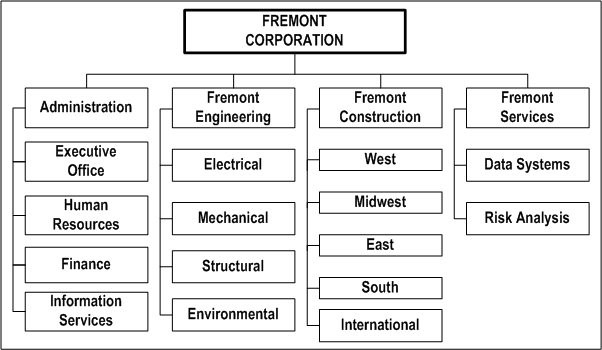Organization hierarchies provide a structure for the relationships between the organizations within your enterprise. They enable you to manage expenditure and reporting data and coordinate project-owning organizations. If your organization uses business groups, you can create project burdening organization hierarchies for each business group.
You define an organization hierarchy by telling Oracle Projects which organizations are subordinate to which other organizations. You can define one organization hierarchy or several, depending on the needs of your enterprise.
There are two basic types of organization hierarchies: ordinary organization hierarchies and global organization hierarchies. To define an ordinary organization hierarchy, you use the Organization Hierarchy window. The organization hierarchy you define there appears in a list of values in the Implementation Options window.
If you have enabled Cross Business Group Access, you can define global organization hierarchies. Global organization hierarchies can contain organizations from any business group. To define a global organization hierarchy, you use the Global Organization Hierarchy window. To access the Global Organization Hierarchy window, you must use a responsibility that is associated with a global security profile.
You can create as many organization hierarchies as you need for different reporting and processing needs, and you can create multiple versions of an organization hierarchy. Oracle Projects uses the hierarchy version to determine which organizations are used for reporting and processing.
You specify a start organization to indicate which branch of your organization hierarchy you want Oracle Projects to recognize as the top of your hierarchy for a particular purpose. If you want to use your entire organization hierarchy, your topmost organization (usually the business group) is the start organization.
The following organization hierarchy versions are assigned to each operating unit in Oracle Projects:
- A Project/Task Owning Organization hierarchy version is assigned to each operating unit. For more information, see Project/Task Owning Organizations.
- An Expenditure/Event Organization hierarchy version is assigned to each operating unit. For more information, see Project Expenditure/Event Organizations.
- A Default Reporting Organization Hierarchy Version is assigned to each operating unit. The hierarchy version can be overridden at reporting time.
- A Project Burdening Hierarchy Version is assigned to each business group. See: Specifying a Project Burdening Hierarchy.
If you currently use Oracle Human Resources, you can use existing hierarchies for Oracle Projects or create new hierarchies. If you do not currently use Oracle Human Resources, you must specify at least one hierarchy for Oracle Projects. You can change these organization hierarchy versions at any time.
Example: Fremont Corporation Organization Hierarchy
Fremont Corporation’s organization hierarchy contains four organizations directly subordinate to its business group. Those organizations in turn have several subordinate organizations of their own.
As per the following illustration of Fremont Corporation’s organization hierarchy, Fremont Corporation’s four divisions are further divided into the following groups:
- Administration has four groups: the Executive Office, Human Resources, Finance, and Information Services.
- Fremont Engineering has four groups: Electrical, Mechanical, Structural and Environmental.
- Fremont Construction has five groups: West, Midwest, East, South and International.
- Fremont Services has two groups: Data Systems and Risk Analysis.
The following illustration shows the organization hierarchy for Fremont Corporation.
Fremont Corporation: Organization Hierarchy Example

Designing Organization Hierarchies to Facilitate Better Searching and Reporting
When you define organization hierarchies, create logical groupings of organizations that you would want to search by. This enables you to control the extent of the searches you perform by entering the name of organizations at different levels of the hierarchy. For example, if you define organizations by regions, you can perform searches by lower levels of a region, and then go up or down the hierarchy to see more or fewer resources.
The accuracy of your search results increases as you increase the granularity of your search criteria. For example, if you only define one organization for all of your resources, that organization will not be a factor in reducing your resource pool. You have to use other search criteria (such as job levels or competencies) to narrow down the field of search results.
In addition to searching, reporting also depends on a good organization hierarchy setup. You need to ensure the organization hierarchy supports the level of reporting that you want to do for one or many organizations rolled up.
If you want to perform resource searching and reporting across business groups, define a global organization hierarchy that contains all of the business groups and subordinate organizations in the hierarchy. When you perform searches, you can define a top level organization in the global hierarchy to search across business groups for project information. You can also use this global hierarchy for reporting if you want to view reports that compare project information across business groups.
There is no need to specify a global organization hierarchy if you do not want to search or do reporting across business groups. Each organization can have a business group specific organization hierarchy defined in their implementation options. By default, all searches start with the business group hierarchy that the user belongs in. You can always search in the organization hierarchies of other business groups. This setup prevents you from searching in more than one business group at a time, however.
Related Topics
Assigning Burdening Hierarchies
Providing Data Across Business Groups
Case Study: Organization Change in Fremont Corporation
Organization Hierarchies, Oracle HRMS Enterprise and Workforce Management Guide
Leave a Reply